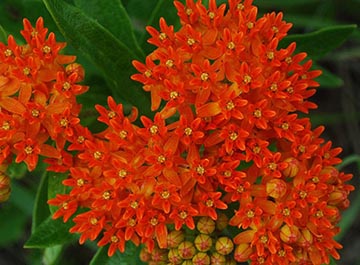
Butterfly milkweed (Asclepias tuberosa) is one of several milkweed species native to Kentucky and the eastern U.S. It is a perennial and relatively easy to identify because it is our only orange milkweed. Unlike other milkweed species, this one lacks the characteristic milky sap. Butterfly milkweed can grow up to three feet tall and have a foot to foot and a half spread when fully mature.
In the wild, butterfly milkweed grows in open, sunny, fairly dry areas. It can grow in pretty rocky, poor soil as long as the soil is well-drained. Butterfly milkweed is also commonly planted as a native landscape plant. However, if it is over-watered, planted in too wet of an area, or too shady of an area then it won’t last long in the garden. Butterfly milkweed likes a little bit of neglect. Because of its long taproot, butterfly milkweed is best grown from seed or transplanted into its permanent location before it gets too large.
The orange flowers are highly attractive to many butterfly and bee species, as well as the occasional hummingbird. Butterfly milkweed can bloom anytime from June until August in Kentucky. Most of the time it will bloom closer to June, but if it was mowed down or planted late then it may bloom later. The fertilized flowers will form seedpods filled with seeds connected to a fluffy white plume. When the ripened seedpod breaks open, the fluffy plumes are caught by the wind and carried to new locations.

A couple of different species of butterfly caterpillars, including that of the monarch butterfly, and at least one species of moth caterpillar eat the foliage of butterfly milkweed. In fact, the real value of milkweed to monarch butterflies is as baby food for the caterpillars and has nothing to do with the flowers or adult butterflies. Butterfly milkweed is notorious for getting aphids in cultivated settings and the aphids can eat young plants to the ground. However, most of the time, the plant will sprout back after the aphids are gone and often it will send up multiple shoots when it resprouts.
If you are looking for an attractive, native plant that is good for honey bees, native bees, and butterflies, butterfly milkweed is a good one to look into. If you have a problem area in your yard that has rocky, hard-packed, relatively dry soil, then definitely look at butterfly milkweed as a possible solution for that location.

This article was part of Shannon’s original Kentucky Pollinators and Backyard Wildlife blog which evolved into the blog for Backyard Ecology.

Backyard Ecology: Exploring Nature in Your Backyard
Nature isn’t just “out there.” It’s all around us, including right outside our doors. Hi, my name is Shannon Trimboli, and I am the host of Backyard Ecology. I live in southcentral Kentucky and am a wildlife biologist, educator, author, beekeeper, and owner of a nursery specializing in plants for pollinators and wildlife conservation. I invite you to join me as we ignite our curiosity and natural wonder, explore our yards and communities, and improve our local pollinator and wildlife habitat. Learn more or subscribe to my email list at www.backyardecology.net.

Leave a Reply